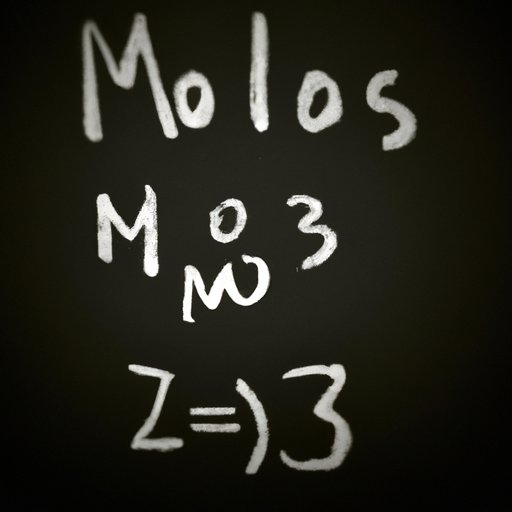
Introduction
Mols, or moles, are a unit of measurement used in chemistry to express the amount of a substance. One mol represents 6.022×10^23 units of that substance, also known as Avogadro’s number. Mols are used in various fields such as medicine, environmental analysis, and many others. Knowing how to calculate mols accurately is essential for scientists and students alike. In this article, we’ll explore the different methods for calculating mols, their real-world applications, and how to avoid common mistakes when working with this unit of measurement.
Step-by-Step Guide for Calculating Mols
The basic formula for calculating mols is:
Mols = Mass (in grams) / Molar Mass (in g/mol)
To better understand this formula, let’s take a closer look at each component:
- Mass is the amount of the substance being considered.
- Molar mass is the mass of one mol of that substance.
Let’s take an example:
What is the mols of carbon dioxide gas in a 10-gram sample?
Step 1: Identify the substance. In this case, it’s carbon dioxide.
Step 2: Find the molar mass of carbon dioxide. Carbon has a molar mass of 12.01 g/mol, while oxygen has a molar mass of 16 g/mol. The molar mass of carbon dioxide is the sum of the molar masses of carbon and oxygen, which is 12.01 + (16 x 2) = 44.01 g/mol.
Step 3: Divide the mass of the substance by its molar mass to get the mols.
10 g / 44.01 g/mol = 0.227 mols
Listicle: Different Methods for Calculating Mols
There are various methods for calculating mols, depending on the information given. Here are some examples:
- Mass Method: This method involves calculating mols using the mass of the substance and the molar mass. We used this method in the previous example.
- Volume Method: This method involves calculating mols using the volume of the substance and its concentration.
- Partial Pressure Method: This method involves calculating mols using the partial pressures of gases in a mixture.
- Ionic Equation Method: This method involves calculating mols using a balanced ionic equation.
It’s important to choose the appropriate method for each scenario. For example, the mass method is appropriate for calculating mols in a solid or liquid substance, while the volume method is appropriate for gases.
Real-World Applications of Mols
Now that we understand how to calculate mols, let’s explore some of their real-world applications:
- Medicine: Mols are used in pharmacology to determine the amount of a drug needed for a patient based on their weight.
- Environmental Analysis: Mols are used to measure the concentration of pollutants in the air or water.
- Nuclear Chemistry: Mols are used to calculate the amount of radioactive elements present in a sample.
- Industrial Chemistry: Mols are used to determine the amount of reactants needed to produce a given amount of product in a chemical reaction.
Visual Aids
Here’s a visual guide to help you calculate mols:

Theory and History of Mols
Avogadro’s number, used to calculate mols, is named after Italian scientist Amedeo Avogadro. He hypothesized that equal volumes of gases at the same temperature and pressure contained the same number of molecules. This theory is now known as Avogadro’s law. The concept of mols was introduced in the early 20th century by Wilhelm Ostwald and was further developed by others, including Richard Willstätter and Fritz Haber. Mols have since become a fundamental unit of measurement in chemistry.
Overcoming Common Mistakes and Challenges in Calculating Mols
One common mistake when calculating mols is using the wrong units for molar mass. You must use g/mol when calculating mols using the mass method. Also, be sure to use the correct formula and double-check your units to avoid calculation errors. Finally, make sure to identify the substance correctly, especially in complex reactions.
Analogies or Metaphors to Explain Mols
One analogy to help explain mols is thinking of them as a dozen in baking. Just as a dozen represents 12 units of something, a mol represents 6.022×10^23 units of a substance. This analogy may not be precise, but it can help to understand the concept of a unit of measurement.
Conclusion
In conclusion, mols are a crucial unit of measurement in various fields of science. It’s essential to know how to calculate mols accurately, as this helps scientists and students to create precise measurements for their research. This article has provided a comprehensive guide for beginners to understand the basic formula and different methods for calculating mols, their real-world applications, and overcoming common mistakes. By understanding the concept of mols, we can better understand the world around us.





